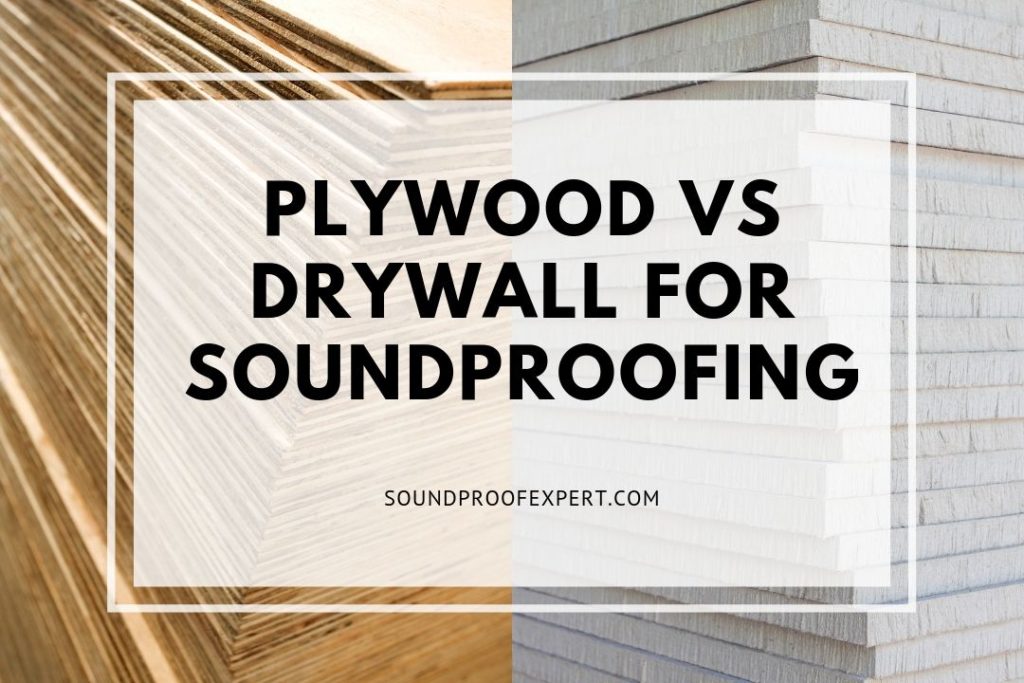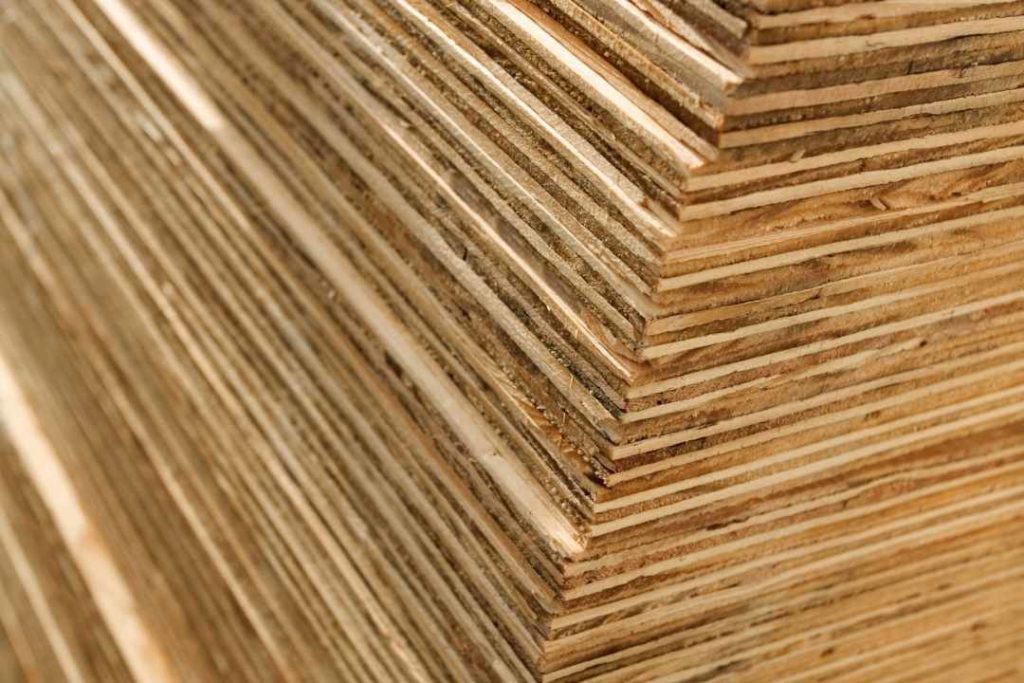
Today, I am going to explain a few different elements of soundproofing to give you a better explanation of what goes into making a room soundproof.
One of the most popular questions I get when it comes to soundproofing is “is drywall more soundproof than plywood?”.
For most applications, drywall is going to be a better soundproofing material than plywood. This is due to the larger mass of the drywall and the fact that sound travels very fast through wood.
Is Drywall Good For Soundproofing?
Drywall, one of the most popular materials used for building interior walls has always been thought of as the superior soundproofing material.
However, drywall installed in builder’s specs are usually not built to soundproof, only to provide a barrier for sound from room to room. However, when installed with soundproofing in mind, it can serve as a great soundproofing material.
There are many ways to install drywall to help soundproof a room with one of the most popular being to double up on the drywall.
When installing a layer of drywall on top of another layer of drywall, it is suggested to use the Green Glue as mentioned earlier.
This will help to dampen sound as it tries to make its way through the two layers of drywall.
Of course, you can always use thicker drywall as well if you are doing a new construction or remodel that requires tearing out old drywall.
Is Plywood Good For Soundproofing?
Plywood offers some soundproofing characteristics, but not as good as drywall.
Sound travels through wood very easily and when used by itself, plywood does not make for a good soundproofing material.
With that being said, it can be used to help with soundproofing certain applications where louder noises are not present.
It also makes for a budget friendly solution to help keep the noise levels down.
Overall, plywood can be used to help with soundproofing but will not provide as much soundproofing as drywall will.

What Other Wall Options Are There For Soundproofing?
When it comes to making a room more soundproof, there are a few more options if you do not want to use plywood or drywall. Sometimes, these materials may not be suitable for the application you want to use them for, which will mean you will need to choose from a couple of alternatives.
The 2 other most popular soundproofing wall materials are MDF (Medium Density Fiberboard) and OSB (Oriented Strand Board).
Both of these boards are a type of wood material and can be used in various different applications.
While they will not provide the soundproofing levels that drywall will, they can still be used when needed.
MDF (Medium Density Fiberboard)
MDF shares a few of the same characteristics of drywall, most notably the thickness of the board, making it almost as effective as drywall when it comes to soundproofing.
One of the major drawbacks is that MDF is quite expensive when comparing it to plywood or drywall and it becomes easily damageable when coming into contact with water.
Being a fiberboard, it is going to absorb moisture fast and be very flammable, making it a choice you will want to leave for last when thinking about using it as a soundproofing material for a wall. MDF is commonly used in subwoofer box construction as it can contain sound very well when sealed and vented properly.
OSB (Oriented Strand Board)
OSB, or oriented strand board, is similar to MDF as it is also made up of various pieces of wood held together by an adhesive. OSB has a unique look as you can easily see the various strands of wood which gives it a more natural look.
You will notice that OSB will be around the same thickness as MDF and have the same soundproofing capabilities. While not as expensive as MDF, it will run a little more than drywall and plywood. OSB also is less receptive to drawing in moisture like MDF, but it will take a while for it to dry out when wet.
How To Help Walls Become More Soundproof
When using any of the above wall materials to soundproof a bedroom, there are other items you can use in conjunction on your wall to get the best performing soundproofing.
These materials can be used to join the materials and will help to absorb sound and reduce vibrations to keep your room quieter.
Each of these materials that I will talk about are used by professionals and DIY minded individuals when preparing a wall for soundproofing.
Let’s take a look at a few different products you can use to help your walls become more soundproof.
Add An MLV (Mass Loaded Vinyl) Sheet
MLV, or Mass Loaded Vinyl (click to see my recommended vinyl on Amazon), is a material that is used to absorb and deflect sound when traveling through a wall.
This vinyl comes in sheets and can easily be hung up by even the most novice DIYer.
There are two basic ways of installing this vinyl, directly to the studs or on top of existing sheetrock.
If you are installing directly to the studs, you can simply staple it to each stud and sheetrock right over it. For those looking to avoid ripping out existing sheetrock, you can attach furring strips to the sheet rock, staple the vinyl to the strips, and then place a new layer of sheetrock on the furring strips.
This will allow you to get the benefits of having both more sheetrock and a layer of MLV without tearing out a wall.
Use Some Acoustic Putty

Acoustic putty (click to see my recommendation on Amazon) is a putty used on soundproofed walls to prevent sound from escaping through cracks, electrical outlets, water hook ups, and HVAC ducts.
The putty is easy to use and can be applied by just about anyone who understands how acoustics can escape from small areas.
This product is available from several different manufacturers and applies in the same way as clay. You simply use it to seal up any areas that sound could escape from to create a nice seal for the room to amplify the acoustics.
It is pretty versatile and can be used on just about any application.
Think About Adding Spray Foam Insulation
Last but not least, you can always look at doing a spray foam insulation treatment to your walls.
Spray foam insulation does the same job as drop in insulation, however, it fills up your walls for a fuller, more complete wall. Spray foam can help to absorb sound while keeping your room the correct temperature, so it’s basically a two in one investment.
This option can be pretty costly, but for everything that you get from it, it may not be a bad idea if you plan to stay in this home for awhile.
Spray foam does not soundproof all sounds and should not be used as an end all solution for keeping your room completely quiet. However, it is a good addition to a staggered stud setup to help fill in the empty cavities between the drywall.
This is also a more involved installation that usually requires a professional company to spray the insulation in, so make sure to take that into consideration when looking at all of your options.
The 4 Elements Of Soundproofing

When it comes to making a room soundproof, you first need to know exactly how sound travels.
This will allow you to better understand which type of soundproofing method is going to work best for you without having to waste unnecessary money or time. Let’s take a look at the 4 elements of soundproofing.
Decoupling
Sound is at the very core, just vibrations. Vibrations travel quite easily through a solid, direct path.
For example, the classic telephone game we all played as a child with the two cans connected by a string work so well due to the string carrying the vibrations from one can to another. By cutting the string, you no longer have a direct path from the source, causing you to not hear what the other person is saying.
In order to build a decoupled wall, you will most likely need to add a new set of framing studs right next to your current studs. However, you will want to offset the new studs in the middle of the other studs.
What this does is give you two walls that are properly secured, but do not touch each other when it comes to stud placement on the drywall or plywood. This allows the sound waves to be disrupted by the offset stud as it does not have a direct pathway to the adjacent wall.
Absorption
When building a decoupling wall, you will still get a bit of sound traveling through the air cavity between the studs.
This is due to the cavity not having anything to stop the vibrations from traveling any further. Although your wall should be much better with a decoupled wall, you can use a little absorption trip to help quiet it down even more.
To help absorb some of this sound, insulation can be added to the cavities to suppress some of this sound. While this is a common method, it is not always the most effective on its own.
Adding it in when using one of the other three methods can help get the full effect of the absorption.
Mass
In order for sound to travel, it will need to be able to move the wall the tiniest bit. This is why making walls heavier is a cost effective, easy way to soundproof a room.
This can include plywood, OSB, cement board, and drywall. Drywall is one of the most common, budget friendly options as you can simply add another layer on top of the existing wall (if it has been prepped for double layering).
When it comes to low-frequency bass, adding more drywall is not always the best option. It will help with soundproofing, but it will not be an end all solution. So with this being said, there is still one more option you can use to get the job done.
Damping
In order to get all of these elements to work together better, you will need to figure out how to prevent the drywall or plywood from vibrating all together. This can be achieved by adding a layer or damping adhesive between the wall materials.
This material, many use a product called Green Glue, will help to adhere two pieces of wall material with a damping agent that help to absorb sound.
This Green Glue has been proven to outperform many of the other damp adhesives on the market and is relatively cheap in cost. It can be used by the most amateur of installers which makes it a great choice for those looking to DIY their own soundproofing project.
Conclusion
Now that I have discussed the different types of soundproofing and whether plywood is better than drywall for soundproofing, you should feel more confident in choosing your new wall material.
Each situation will be different, so make sure to take all factors into consideration when choosing your material. Make sure to check your local codes to ensure the materials you use are up to code spec for your city.
Have you soundproofed a room before? Did you make a choice between plywood or drywall? What other steps did you take to ensure that you reduced the amount of sound transmitting through your walls?

Thank you for the info! I just bought a new place and I get deep bass sound and vibration from the house from a power plant that is 2.5 miles away. The constant hum has this up and down hum to it that affects my sleep and just annoys me.
So, what I’m trying to do is get low frequency bass out of the house. Based on your experience do you think the following setup would help to remove the bass hum from the power plant?
Set up: Existing wall 2×4 w/ fiberglass toward interior > MLV then resilient channel then drywall/greenglue/drywall.
Thanks!
Wow, This is interesting. But would it be better if plywood is much thicker ? Great article by the way.